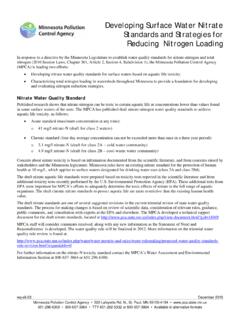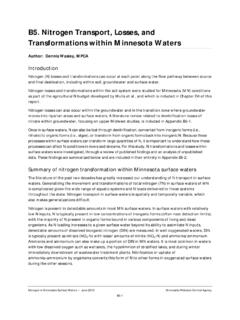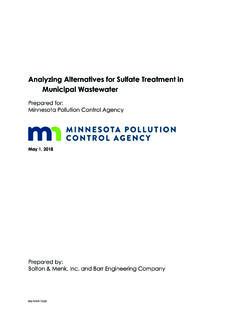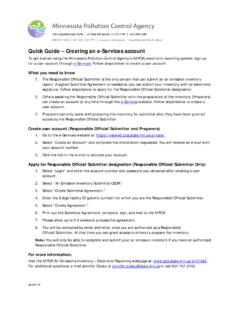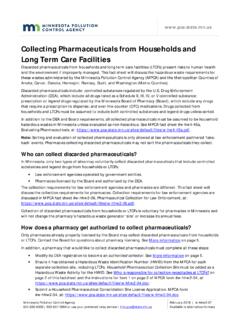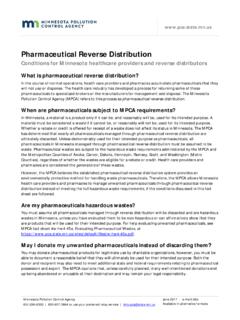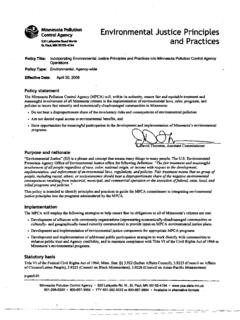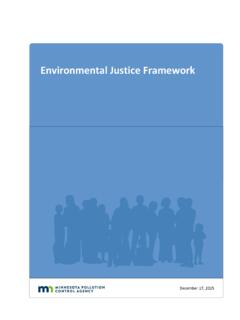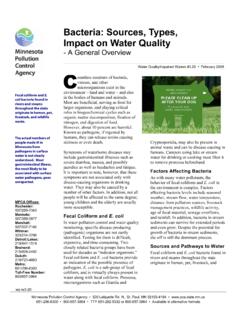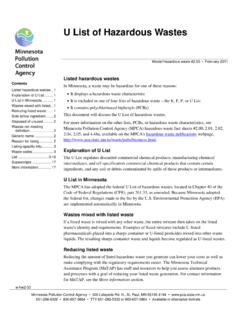Transcription of Excavation of Petroleum-Contaminated Soil and Tank …
1 Excavation of Petroleum-Contaminated soil and tank removal sampling petroleum Remediation Program This document describes the requirements for excavating Petroleum-Contaminated soil and for sampling during regulated petroleum tank removal when a release has occurred. General soil Excavation requirements are provided as well as requirements for specific circumstances such as tank removal and installation. Sampling is required following tank removal to quantify residual contaminant levels and to determine whether further investigation is needed. Release Reporting Detection of any amount of contamination in soil or groundwater must be reported to the Minnesota Duty Officer, even if contaminant levels are lower than the action levels stated below.
2 Emergency Conditions If there was a recent release, or there are vapor impacts, drinking water impacts, surface water impacts, free product, or a potentially unstable condition, immediately contact the Minnesota Duty Officer. Additional Information Additional guidance on release reporting, release response, and emergency conditions is found in Reporting of petroleum Releases, Light Non-Aqueous Phase Liquid Management Strategy, Recent Releases at petroleum Tank Sites, and the petroleum Remediation Program General Policy. I. General Excavation requirements A. Excavation prior to a limited site investigation contaminated soil may be excavated prior to completing a limited site investigation (LSI) in the situations listed below.
3 Otherwise, contaminated soil should remain in place until an LSI has been completed. Identifying receptors, defining the extent and magnitude of contamination, and evaluating risk during the LSI. will determine if Excavation is appropriate. 1. All contaminated soil meeting any of the field screening criteria listed in Table 1 can be excavated within a maximum of 200 cubic yards, providing that groundwater is not impacted or likely to become impacted. See subsection B below for more details. Prior Minnesota Pollution Control Agency (MPCA). approval is required to excavate more than 200 cubic yards of soil .
4 Minnesota Pollution Control Agency March 2017 | c-prp3-01. 651-296-6300 | 800-657-3864 or use your preferred relay service | Available in alternative formats Table 1. Field screening criteria soil headspace screening level petroleum product (ppmv*) Visual evidence petroleum sheen test Gasoline, ethanol-blended fuel, and 40 or above aviation gasoline Visual evidence of Positive sheen test Diesel fuel, fuel oil, used or waste oils, petroleum staining result 10 or above jet fuel, kerosene *ppmv (parts per million by volume). 2. petroleum -saturated or grossly contaminated soil is accessible such as during tank removal or installation.
5 Excavation Limits Excavate up to 200 cubic yards of contaminated soil that is The total Excavation volume allowed petroleum saturated or grossly contaminated . Use the under subsections 1 and 2, applied petroleum sheen test to determine if soil is petroleum separately or in combination, cannot saturated. Use soil headspace screening with a exceed 200 cubic yards without prior photoionization detector (PID) to determine if soil is grossly MPCA approval. This limit is not contaminated . soil with PID readings of 200 parts per applicable to subsections 3, 4, or 5, million by volume (ppmv) or above is considered grossly where site-specific circumstances contaminated .
6 soil headspace screening and petroleum dictate Excavation volume. sheen test procedures are described in soil Sample Collection and Analysis Procedures. In certain situations, the site-specific risk scenario may justify excavating more than 200 cubic yards. Please contact the MPCA for approval to exceed the 200 cubic yard limit. 3. A recent release has occurred. Quick removal of contamination can prevent the expansion of a contaminant plume. See Recent Releases at petroleum Tank Sites for more information. 4. An obvious emergency condition exists where soil Excavation is an appropriate interim corrective action.
7 Refer to the petroleum Remediation Program General Policy for more information on emergency conditions, and contact the MPCA for site-specific guidance. 5. Excavation is necessary to facilitate tank system installations (see Section II). B. Situations requiring a limited site investigation An LSI is necessary if any of the following situations exist: 1. Contamination cannot be addressed by Excavation of 200 cubic yards or less of soil . 2. Groundwater is present in the Excavation and has been in contact with either petroleum product or Petroleum-Contaminated soil , or groundwater contamination is suspected.
8 3. Contamination intercepts a seasonally high water table (indicated by mottling on the Excavation sidewalls) or bedrock. 4. Other impacts are known or suspected ( , discharge of contaminated water to surface waters or sewers, vapor impacts to buildings or utilities, etc.). 5. Residual soil contamination meets any of the field screening criteria in Table 1 or has a soil analytical result greater than 100 mg/kg gasoline range organics (GRO) or diesel range organics (DRO). 6. contaminated groundwater is encountered in post- Excavation soil borings (see subsection C below).
9 Page 2 of 10 March 2017 | c-prp3-01. C. Post- Excavation soil borings A soil boring(s) is necessary at sites with sandy or silty sand soil (Unified soil Classification System/American Society for Testing Materials) and where the water table is within 25 feet of the ground surface. The purpose of this boring(s) is to determine whether or not an LSI is necessary. Advance a soil boring directly through each suspected source area ( , former tank locations, dispensers, and piping runs) in the following situations: a. soil contamination from a suspected source area Excavation is between 1 and 100 mg/kg GRO/DRO; or b.
10 Visual or other evidence of contamination remains in a suspected source area. Collect and analyze soil samples following the procedures and analytical requirements described in soil Sample Collection and Analysis Procedures. Collect and analyze groundwater samples following the procedures and analytical requirements described in Groundwater Sample Collection and Analysis Procedures. If the boring(s) encounters contaminated groundwater, an LSI is necessary. If the boring(s) encounters historical contamination that does not intersect the water table and the groundwater sample is not contaminated , an LSI may not be necessary depending on the likelihood of groundwater becoming contaminated .
